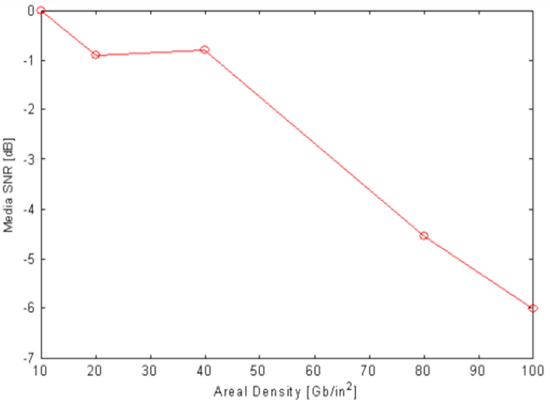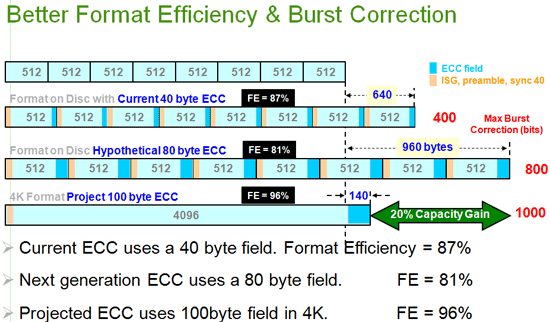Western Digital’s Advanced Format: The 4K Sector Transition Begins
by Ryan Smith on December 18, 2009 12:00 AM EST- Posted in
- Storage
We had a chance to talk to Western Digital last week about a new hard drive technology they have coming down the pipe called Advanced Format. Ahead of the impending launch of the first Advanced Format drives, Western Digital is engaging in an education campaign about the technology, as it represents the first step in a general transition for hard drives, and is a transition that can’t be done completely behind the scenes. Specifically, Advanced Format is going to bring about some issues where older operating systems (and we’re looking almost exclusively at Windows XP here) will inadvertently harm drive performance by making certain assumptions about the drives that will no longer be true.
We’ll get in to the nitty-gritty about the impact of this in a bit, but first let’s start with Advanced Format. What is it? In a nutshell, it’s replacing the traditional 512 byte hard drive sector with a 4 kilobyte (4,096B) hard drive sector for a number of practical and technological reasons. Advanced Format is the name Western Digital is giving to drives implementing 4KB sectors.
The move to 4K-sectors has been some 10 years in the making, as research in the late 90’s identified that 512B sectors made less and less sense as drives continued to get larger. At a time when hard drives were measured in megabytes, 512B sectors were a good balance between technical factors and a desire to keep wasted space at a minimum (you can’t normally put 2 files in 1 sector), but times have changed and hard drive capacities are several orders of magnitude larger.
The crux of the problem is that there are 3 factors that are in constant need of balancing when it comes to hard drive design: areal density, the signal-to-noise ratio (SNR) in reading from drive platters, and the use of Error Correcting Code (ECC) to find and correct any errors that occur. As areal density is increases, sectors become smaller and their SNR decreases. To compensate for that, improvements are made to ECC (usually through the use of more bits) in order to maintain reliability. So for a drive maker to add more space, they ultimately need to improve their error-correction capabilities, which means the necessary ECC data requires more space. Rinse, wash, repeat.

The SNR for various areal densities
At some point during this process drive manufacturers stop gaining any usable space - that is, they have to add as much ECC data as they get out of the increase areal density in the first place - which limits their ability to develop larger drives. Drive manufacturers dislike this both because it hinders their ability to develop new drives, and because it means their overall format efficiency (the amount of space on a platter actually used to store user data) drops. Drive manufacturers want to build bigger drives, and they want to spend as little space on overhead as possible.
But all is not lost. The principle problem here is that ECC correction takes place in 512B chunks, while ECC can be more efficient when used over larger chunks of data. If ECC data is calculated against a larger sector, even though more ECC data is necessary than for a single 512B sector, less ECC data than the sum of multiple sectors is needed to maintain the same level of operational reliability. One estimate for 4K sector technology puts this at 100 bytes of ECC data needed for a 4K sector, versus 320 (40x8) for 8 512B sectors. Furthermore the larger sectors means that larger erroneous chunks of data can be corrected (burst error correction), something that was becoming harder as greater areal densities made it easier to wipe out larger parts of a 512B sector. As a result, the need for the larger sector is born.

As for why Western Digital and other drive makers are transitioning specifically to a 4K sector, the rationale is based on the earlier problems. 4K sectors are much larger than 512B sectors, which means they benefit more from our earlier ECC optimizations, which in turn brings a greater increase in format efficiency than using smaller sectors (i.e. 1K).
4K also happens to be a magical number elsewhere when it comes to computers – this is primarily rooted in the fact that a normal page of memory on an x86 processor continues to be 4KB (ed: 4MB pages also exist). The x86 page size in turn has also lead to file system clusters (the smallest unit of storage in a file system) becoming 4KB as 4KB clusters neatly fit in to a page of memory, while the need for smaller clusters has subsided amidst a general increase in file size (i.e. fewer files are smaller than 4KB and waste space). NTFS, EXT3, and HFS+ all default to 4KB clusters on modern hard drives. So 4KB physical sectors map perfectly with 4KB file system clusters, which in turn map perfectly with 4KB memory pages. And hence 4KB is the largest practical size for a hard drive sector at this time.
| Old Sector | New Sector | x86 Mem Page | NTFS Cluster | HFS+ Cluster | |
| Size | 512B | 4K | 4K | 4K | 4K |
So what’s the net benefit from all of this for consumers? At the moment, not a lot, which is why this is a low-key launch for Western Digital, and the focus of this is an education effort on what the use of 4K sectors means for older operating systems. The biggest benefit is going to be that this will enable Western Digital to more easily design drives over 2TB in size.
From a numbers perspective, Western Digital estimates that the use of 4K sectors will give them an immediate 7%-11% increase in format efficiency. ECC burst error correction stands to improve by 50%, and the overall error rate capability improves by 2 orders of magnitude. In theory these reliability benefits should immediately apply to all 4K sector drives (making the Advanced Format drives more reliable than regular drives), but Western Digital is not pushing that idea at this time.

IDEMA projected format efficiency and ECC burst sizes
With all of that said, to make this kind of advancement practical, a transition period is necessary. That transition period will be done through the use of 512B emulation technology, which will expose Advanced Format drives to the drive controller and operating system as having 512B sectors, when in reality they will have 4K sectors. Unfortunately, this method has a downside, which is the ultimate reason for Western Digital’s education campaign.

512 byte sector emulation: how the drive is laid out (physical) and what the OS sees (logical)
With the emulation of 512B sectors, there’s the risk that a partition could be misaligned compared to the 4K physical sectors - where it would be unwittingly started in the middle of such a sector. As a result, the clusters of a file system on that partition would end up straddling 4K sectors, which would cause performance problems. Specifically, in testing IDEMA (the drive manufacturers’ trade group) found that random writes in would be particularly impacted, as a Read-Modify-Write(RMW) would need to take place to update each sector, rather than a straight write(ed: This is very similar to writing to a dirty block on a SSD). Although this isn’t mechanically/electronically harmful in any way, the performance hit compared to a straight write makes it undesirable.

A single unaligned 4K cluster straddling 2 physical sectors

A misaligned partition under WinXP. Only LBAs divisible by 8 are aligned










86 Comments
View All Comments
strikeback03 - Friday, December 18, 2009 - link
I'd imagine these "power users" would be the ones using an OS that knows what to do with 4k sectors, and would not have the performance problems XP would. And it would be nice if they had a jumper setting (enabled as shipped) to enable or disable the 512b emulation. Thus the only ones likely to disable the 512b emulation are the ones who know what they are doing.wolrah - Friday, December 18, 2009 - link
This is my thought as well. When SATA2 was new and some first-gen SATA controllers were found to have problems with drives running in SATA2 mode, Seagate shipped their Barracuda 7200.8 (I think) with a jumper installed that disabled SATA2 by default. At the time there was little performance benefit unless you had support for NCQ the whole way up the stack and were multitasking heavily, so most users probably still to this day have that jumper installed whether they need it or not and are none the wiser. Those who knew what they're doing however could remove the jumper and gain a slightly faster burst transfer rate out of disk cache and the various protocol enhancements such as NCQ.leexgx - Saturday, December 19, 2009 - link
due to hdds not braking past 90MB/s the jumper on made there drives the most compatible drives around as i have had problems in the past with puling that jumper off on some motherboards (or none segate hdds) not working stable with Sata 2same issue with Nvidia and Sata 2 on there apple systems wish SSDs had an option to set Sata 1 mode as the only SSD that you most likely going to always work is the corsair S128 as its Sata 1 only
Mr Perfect - Friday, December 18, 2009 - link
Yes, that would be a great option. I can't be the only one who'd love to enable real 4KB sectors on all of my Windows 7 machines going forward.ltcommanderdata - Friday, December 18, 2009 - link
So Mac OS X doesn't seemed to have problems with Advanced Format, but what about Boot Camp? Will XP Boot Camp still have issues while Vista and Windows 7 Boot Camp won't or does the Boot Camp partition utility automatically properly aligns things for even Windows XP.Lukas - Sunday, December 20, 2009 - link
The bootcamp partitions aren't created by Windows XP, they're created by Mac OS X. Without having studied it, i'd bet that they will be aligned.Ryan Smith - Friday, December 18, 2009 - link
Good question; I don't have an answer to that.Mr Perfect - Friday, December 18, 2009 - link
I don't know if WD is answering followup questions, but could you ask if other virtual machines have this problem too? Specifically, I'm thinking of Windows 7's XP mode.leexgx - Saturday, December 19, 2009 - link
xp mode is an add-on to windows 7, as windows 7 will all ready be installed the XP mode install does not work at the disk level when it is installed (does not create partitions)for vmware if its File based VMs it same as win7 XP mode its not working at disk level when partitions are been made inside the VMs(think VMware can be disk based thought but most use file based)
pcfxer - Friday, December 18, 2009 - link
As of December 18, 2009, Bootcamp does NOT align the sectors any differently than the Microsoft installer would.